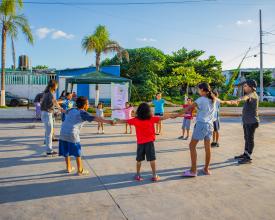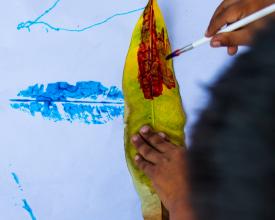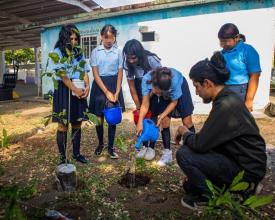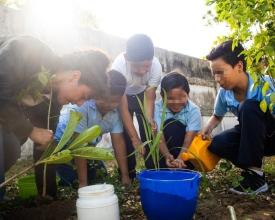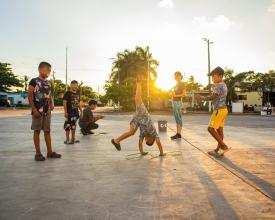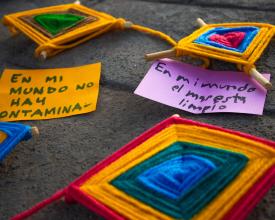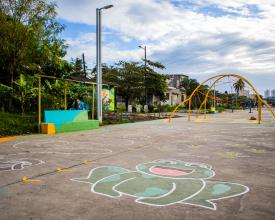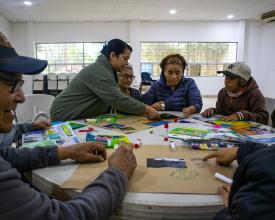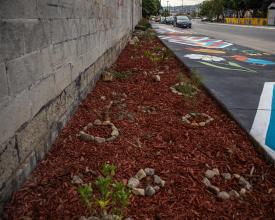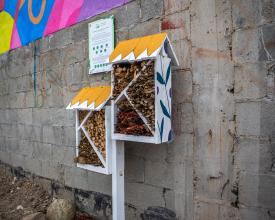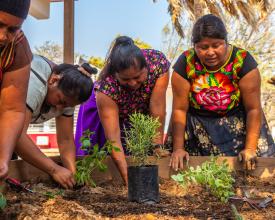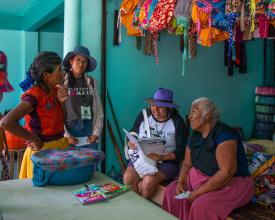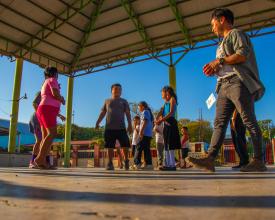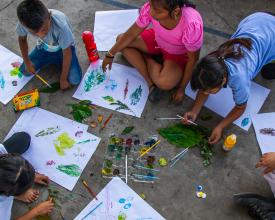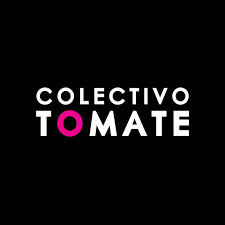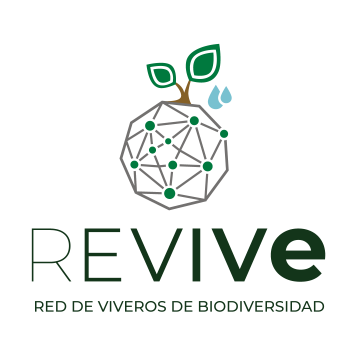
Sowing Cities
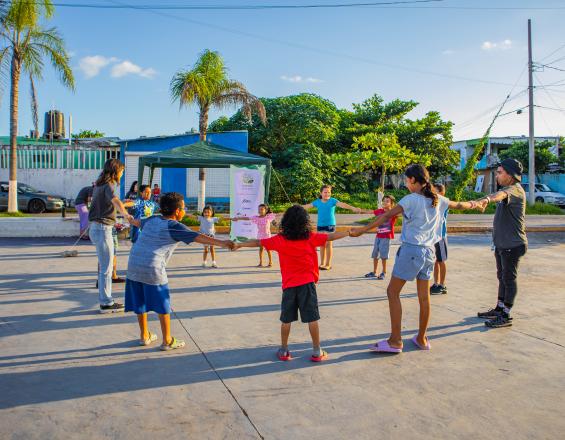
In the face of an eminent climate crisis, its consequences and effects are becoming increasingly evident, and we can now experience them in cities. Floods, heat islands, poor air quality, extreme weather phenomena, difficulties in access to basic services and, therefore, to a good quality of life; these are now the problems we are experiencing and the challenges we will face. When we add to these facts, a constant growth of urbanization, a lack of land use planning and gray infrastructure in cities, they become elements that will complicate future scenarios, however, these aspects are also key areas of opportunity to combat the climate crisis.
Sembrando Ciudades was born as an initiative that seeks to promote resilient communities in the face of climate change through the implementation of demonstration projects using nature-based solutions and participatory processes that promote adaptation to climate change.
Context
Challenges addressed
This multisectoral project was promoted by the Ministry of Agrarian, Territorial and Urban Development (Sedatu), Comex for a Well-Done Mexico, the German Cooperation for Sustainable Development (GIZ) GmbH, through the Sustainable Development of Urban Coastal Regions through the Integration of Ecosystem Services and Biodiversity (BIOCITIS) program, and the civil associations Colectivo Tomate and the Network of Biodiversity Nurseries (REVIVE).
One of the main characteristics of this initiative is its adaptive capacity, that is, the possibility of contextualizing the proposed solutions to the specific needs of each city, and the incorporation of a gender perspective, allowing the inclusion and representation of all beneficiaries.
Location
Process
Summary of the process
Through a national call launched in conjunction with Sedatu, 13 coastal cities applied, of which, based on selection criteria, 5 were chosen for the implementation of a demonstration project (per city) of public space and green infrastructure with a focus on integrated disaster risk management, in order to strengthen strategies and actions for adaptation to climate change in coastal public spaces under a strategy of feasibility, training, communication and social involvement.
The selected cities were:
- Boca del Río, Veracruz,
- Tijuana, Baja California
- San Mateo del Mar, Oaxaca
- Tepic, Nayarit
- Merida, Yucatan
The following is a description of the methodology implemented in each city and the results obtained in each edition of the Sembrando Ciudades project.
Building Blocks
Methodology
Sembrando Ciudades has two major components, the technical process and the participatory process with the community, for which each of the consulting teams has expertise in one of the two areas, and combined, it was possible to maximize its scope and impact. For the more technical component, the REVIVE team carried out a series of strategies and local actions in favor of the conservation, improvement and expansion of urban trees and green infrastructure, generating a spatial and operational toolbox to promote informed decision making on urban greening needs. Colectivo Tomate led the participatory processes by promoting the construction of a community model through multiple activities of environmental awareness and integrated risk management, strengthening the inhabitants to face the current challenges and appropriate the demonstrative solution to promote climate adaptation installed in the public space.
Throughout the work with each city, there were different stages according to the type of activities carried out:
- Preliminary
First approach with local officials, population and civil society involved with each city, in order to present the vision and objective of the project, as well as to generate a communication network to support the logistics of the implementation of all the activities to be carried out.
Spatial diagnosis of the selected site in terms of urban trees, pollution indexes, heat islands, among others, as well as a face-to-face analysis of the site to determine the feasibility of implementation aligned with the objectives of the initiative.
- Awareness-raising
Meetings with the community surrounding the implementation site where the field team introduces itself and explains the project's objective. Using a socio-artistic methodology, spaces are created to meet and dialogue with the people to learn about their needs, and thus begin to build a collaborative proposal sufficient to execute a demonstrative action in the public space that meets local needs.
- Socialization and training
Capacity building for the community and local officials, through awareness raising and socialization of essential concepts to address the climate crisis.
- Implementation
Installation of demonstrative actions that favor climate adaptation and meet local needs, promoting environmental and social connectivity in the area, as well as color interventions through murals and floor painting to promote the habitability and enjoyment of the space by children and neighbors.
- Closing
Commemorative space for the delivery of the results of the project, recognizing all the key actors involved, and community participation.
Sowing Cities: Boca del Río
The first edition of the project took place in Boca del Río, Veracruz, where the logistics and execution of the activities at the selected implementation site were worked out in conjunction with the municipality's City Hall.
The Parque Lineal Dren B, due to its needs related to construction characteristics, dynamism of activities and proximity to school equipment, represented an ideal site. It is composed mostly by a long pavement slab and few tree species that provide shade, when combining these characteristics with the climatic conditions of the area, it potentiates the heat island effect, making its habitability complicated during daylight hours with sunlight due to the high temperatures reached; and due to the high rainfall, accumulation of urban solid waste in the sewage system and high ground surface sealed with pavement, there are usually areas with flooding, promoting the generation of bad odors and affecting the inhabitants of the area.
The solutions for this edition of the project were oriented to generate a water infiltration garden, greater shade spaces and the construction of play options for children, accompanied by color interventions throughout the park.
The results were:
Environmental connectivity device - demonstration project.
- 25m2 infiltrative garden
- Unstructured playground of 42.31m2
- 2 interventions in urban furniture elements, pergolas on two benches (2.16m2 and 1.45m high).
- Installation of informative and environmental education screens on Arroyo Moreno (in collaboration with Ecopil) along the Dren B Linear Park.
Painting of murals and floor:
- 202.24m2 of mural painting.
- 170m2 of floor painting.
Community workshops:
- 6 outreach and dissemination activities.
- 4 workshops and participatory outreach activities with 36 participants.
- 6 workshops and participatory activities on Integrated Risk and Disaster Management (IRDM) for 45 people.
Workshops for civil servants:
1 practical workshop (face-to-face) and theoretical course (virtual) on technical strengthening for the diagnosis and management of urban trees.
Reforestation in an elementary school in the Metropolitan Zone of Veracruz and a practical workshop on urban reforestation for students and teachers.
- Twenty-eight students actively participated.
- The impact of these interventions extends to the entire student community, equivalent to 540 students and 26 teachers.
- A total of 25 species were reforested, including majestic trees, medium-sized trees, shrubs and aromatic plants.
- Impact area of 4,248m2
Resources
Sowing Cities: Tijuana
Tijuana, Baja California, was the second city to implement the initiative. For this edition, we worked together with the Metropolitan Planning Institute of Tijuana (IMPLAN), determining as the implementation site the Third Stage of the Tijuana River, this area presented difficulties of accessibility for pedestrians, lack of shaded areas and green areas.
The results were:
Environmental connectivity device - demonstration project.
- 32m2 revegetation space with native species, accompanied by substrates and mulching to promote infiltration of rainwater to the subsoil and reduce the effects of heat islands.
- 2 hotels for pollinators
- 4 elements of urban furniture printed in 3D technology by Holcim (four benches donated thanks to a collaboration with the private sector).
Mural and floor painting
- 200m2 of mural painting
- 200m2 of floor painting which consisted of games for children.
Community workshops:
- 2 workshops and participatory outreach activities delivered to 20 participants.
- 6 workshops and participatory activities on Integrated Risk and Disaster Management (IRDM) for 46 people.
Workshops for civil servants:
1 practical workshop (face-to-face) and theoretical course (virtual) on technical strengthening for the diagnosis and management of urban trees.
Resources
Sowing Cities: San Mateo del Mar
The next city selected was San Mateo del Mar in Oaxaca, this location has multiple current and future challenges regarding the climate crisis, its location and geographical conditions make it a city highly vulnerable to the effects of climate change.
Together with the Municipal Government of San Mateo del Mar, we were able to work closely with the Ikoots community, the Institute of Indigenous Peoples (INPI) and the Indigenous Women's House (CAMI). The implementation site was the Espinal Sports Field, with a shaded and revegetation space, and in the CAMI with a support space to preserve and promote the community's ancestral knowledge.
The results were:
Environmental connectivity device - demonstration project.
- Cultivation bed 2.5 m long, 1.25 m wide and 0.50 m deep, for the cultivation of medicinal plants for community use.
- Revegetation of 289 m2 with various tropical species selected for their ability to tolerate soil salinity and drought conditions in the El Espinal Sports Field.
- Implementation of a 6 m long, 4.2 m wide, and 4.4 m high space at the El Espinal Sports Field, using traditional and local techniques and materials.
Mural and floor painting
- 228 m2 of mural painting
- 200 m2 of floor painting in a sports field.
Community workshops:
- 4 workshops and participatory outreach activities delivered to 41 participants.
- 4 workshops and participatory activities on Integrated Risk and Disaster Management (IRDM) for 58 people.
Workshops for civil servants:
- 1 theoretical (virtual) course on technical strengthening for the diagnosis and management of urban trees.
Resources
Sowing Cities: Tepic
The Sembrando Ciudades initiative is working on its field activities in this fourth city in the state of Nayarit.
Sowing Cities: Merida
The Sembrando Ciudades initiative is working on its field activities in this fourth city in the state of Yucatan.
Impacts
The project has achieved the following intangible results:
- 32 environmental awareness and education workshops.
- 3 workshops with local officials and decision-makers on urban trees.
- Incorporation of a gender perspective throughout the project. Achieving inclusion and representation of women, children and indigenous communities, as well as their involvement and participation in the planning and design of the demonstration action.
- Community strengthening to face climate challenges and promote resilience in coastal cities.
- Strategic alliances with CSOs in each city
- Building collaborations with community stakeholders that became project partners
- Toolkits per city to support informed decision making on urban greening needs, management and diagnosis of urban trees
- Demonstrative examples of nature-based solutions and green infrastructure needed in cities to promote climate adaptation, risk prevention and urban resilience
- Partnership with the private sector for the donation of furniture elements, thanks to the collaboration with Holcim, four benches printed with a 3D technology that allows for energy savings and efficiency in energy and material use.
- Promote the preservation of local biodiversity, native species for medicinal and pollinator use.
Beneficiaries
The Sembrando Ciudades initiative, with three cities completed, has directly benefited approximately 10,600 people and indirectly 18,300 people.

